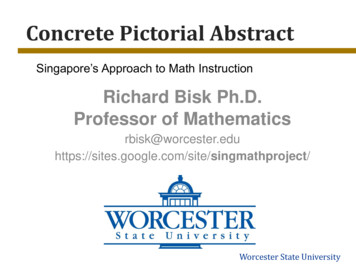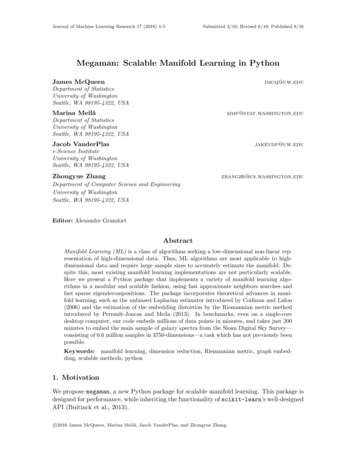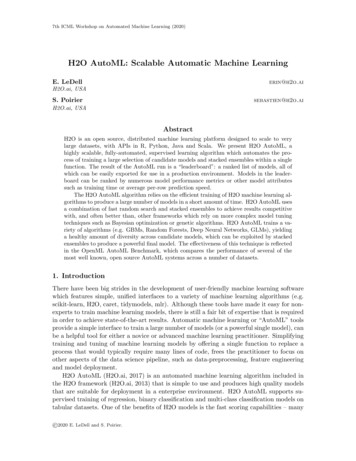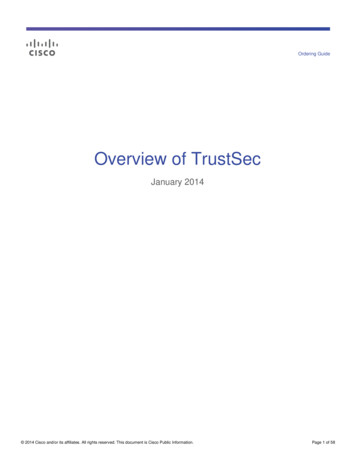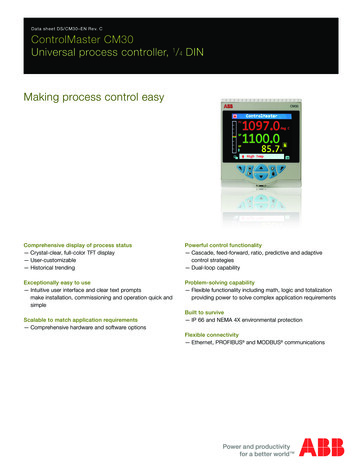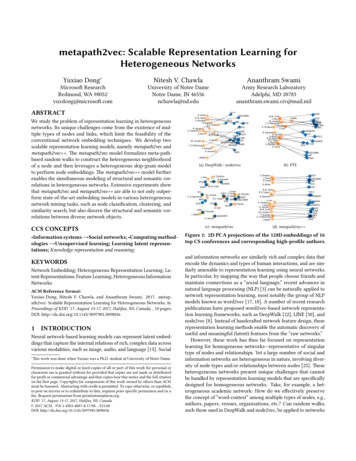
Transcription
metapath2vec: Scalable Representation Learning forHeterogeneous NetworksYuxiao Dong Nitesh V. ChawlaAnanthram SwamiMicrosoft ResearchRedmond, WA 98052yuxdong@microsoft.comUniversity of Notre DameNotre Dame, IN 46556nchawla@nd.eduArmy Research LaboratoryAdelphi, MD 20783ananthram.swami.civ@mail.milABSTRACTWe study the problem of representation learning in heterogeneousnetworks. Its unique challenges come from the existence of multiple types of nodes and links, which limit the feasibility of theconventional network embedding techniques. We develop twoscalable representation learning models, namely metapath2vec andmetapath2vec . The metapath2vec model formalizes meta-pathbased random walks to construct the heterogeneous neighborhoodof a node and then leverages a heterogeneous skip-gram modelto perform node embeddings. The metapath2vec model furtherenables the simultaneous modeling of structural and semantic correlations in heterogeneous networks. Extensive experiments showthat metapath2vec and metapath2vec are able to not only outperform state-of-the-art embedding models in various heterogeneousnetwork mining tasks, such as node classification, clustering, andsimilarity search, but also discern the structural and semantic correlations between diverse network objects.CCS CONCEPTS Information systems Social networks; Computing methodologies Unsupervised learning; Learning latent representations; Knowledge representation and reasoning;KEYWORDSNetwork Embedding; Heterogeneous Representation Learning; Latent Representations; Feature Learning; Heterogeneous InformationNetworksACM Reference format:Yuxiao Dong, Nitesh V. Chawla, and Ananthram Swami. 2017. metapath2vec: Scalable Representation Learning for Heterogeneous Networks. InProceedings of KDD ’17, August 13-17, 2017, Halifax, NS, Canada, , 10 pages.DOI: TIONNeural network-based learning models can represent latent embeddings that capture the internal relations of rich, complex data acrossvarious modalities, such as image, audio, and language [15]. Social Thiswork was done when Yuxiao was a Ph.D. student at University of Notre Dame.Permission to make digital or hard copies of all or part of this work for personal orclassroom use is granted without fee provided that copies are not made or distributedfor profit or commercial advantage and that copies bear this notice and the full citationon the first page. Copyrights for components of this work owned by others than ACMmust be honored. Abstracting with credit is permitted. To copy otherwise, or republish,to post on servers or to redistribute to lists, requires prior specific permission and/or afee. Request permissions from permissions@acm.org.KDD ’17, August 13-17, 2017, Halifax, NS, Canada 2017 ACM. 978-1-4503-4887-4/17/08. . . 15.00DOI: http://dx.doi.org/10.1145/3097983.3098036D. SongR. N. TaylorS. ShenkerO. MutluR. E. TarjanJ. HanR. AgrawalA. TomkinsJ. DeanW. B. CroftH. IshiiM. I.JordanC. D. ManningT. KanadeH. SIGGRAPH KDDSIGMOD SIGIRW. B. CroftJ. HanM. I.JordanC. D. ManningT. KanadeA. TomkinsSIGIRJ. MalikH. IshiiR. AgrawalH. JensenO. MutluR. N. TaylorR. E. TarjanJ. DeanS. ShenkerD. a) DeepWalk / node2vecJ. HanSIGIRA. TomkinsR. AgrawalWWWW. B. CroftSIGMODJ. DeanFOCS D. SongS. ShenkerM. I.JordanR. N. TaylorC. D. ManningOSDIR.E.TarjanNIPSS&PSIGCOMMICSECHIIJCAIO. MutluISCAH. IshiiCVPRT. KanadeJ. MalikSIGGRAPHH. JensenACL(c) metapath2vecSIGMODSIGCOMMS&POSDIJ. MalikKDDICSE(b) PTES. ShenkerJ. DeanD. SongO. MutluR. N. TaylorR. E. TarjanOSDISIGCOMMS&PISCAICSEFOCSSIGMODR. AgrawalCHIH. IshiiA. TomkinsJ. HanH. JensenW. B. CroftM. I.JordanT. KanadeC. D. ManningJ. MalikWWWSIGGRAPHKDDSIGIRIJCAINIPSACLCVPR(d) metapath2vec Figure 1: 2D PCA projections of the 128D embeddings of 16top CS conferences and corresponding high-profile authors.and information networks are similarly rich and complex data thatencode the dynamics and types of human interactions, and are similarly amenable to representation learning using neural networks.In particular, by mapping the way that people choose friends andmaintain connections as a “social language,” recent advances innatural language processing (NLP) [3] can be naturally applied tonetwork representation learning, most notably the group of NLPmodels known as word2vec [17, 18]. A number of recent researchpublications have proposed word2vec-based network representation learning frameworks, such as DeepWalk [22], LINE [30], andnode2vec [8]. Instead of handcrafted network feature design, theserepresentation learning methods enable the automatic discovery ofuseful and meaningful (latent) features from the “raw networks.”However, these work has thus far focused on representationlearning for homogeneous networks—representative of singulartype of nodes and relationships. Yet a large number of social andinformation networks are heterogeneous in nature, involving diversity of node types and/or relationships between nodes [25]. Theseheterogeneous networks present unique challenges that cannotbe handled by representation learning models that are specificallydesigned for homogeneous networks. Take, for example, a heterogeneous academic network: How do we effectively preservethe concept of “word-context” among multiple types of nodes, e.g.,authors, papers, venues, organizations, etc.? Can random walks,such those used in DeepWalk and node2vec, be applied to networks
Table 1: Case study of similarity search in the heterogeneous DBIS data used in [26].MethodPathSim [26]DeepWalk / node2vec [8, 22]LINE (1st 2nd) [30]PTE [29]metapath2vecmetapath2vec Inputmeta-pathsheterogeneous random walk pathsheterogeneous edgesheterogeneous edgesprobabilistic meta-pathsprobabilistic meta-pathsQueryPKDDC. FaloutsosPKDDC. FaloutsosPKDDC. FaloutsosPKDDC. FaloutsosPKDDC. FaloutsosPKDDC. Faloutsos12345ICDMSDMPAKDDKDDDMKDJ. HanR. AgrawalJ. PeiC. AggarwalH. JagadishR. S.M. N.R. P.G. G.F. J.J. PanH. TongH. YangR. FilhoR. ChanW. K.S. A.A. B.M. S.S. A.C. AggarwalP. YuD. GunopulosN. KoudasM. VlachosKDDICDMSDMDMKDPAKDDC. AggarwalP. YuY. TaoN. KoudasR. RastogiA. S.M. B.P. B.M. S.M. K.C. AggarwalJ. PeiP. YuH. ChengV. GantiKDDPAKDDICDMDMKDSDMR. AgrawalJ. HanJ. PeiC. AggarwalP. Yuof multiple types of nodes? Can we directly apply homogeneousnetwork-oriented embedding architectures (e.g., skip-gram) to heterogeneous networks?By solving these challenges, the latent heterogeneous networkembeddings can be further applied to various network mining tasks,such as node classification [13], clustering [27, 28], and similaritysearch [26, 35]. In contrast to conventional meta-path-based methods [25], the advantage of latent-space representation learning liesin its ability to model similarities between nodes without connectedmeta-paths. For example, if authors have never published papers inthe same venue—imagine one publishes 10 papers all in NIPS andthe other has 10 publications all in ICML; their “APCPA”-based PathSim similarity [26] would be zero—this will be naturally overcomeby network representation learning.Contributions. We formalize the heterogeneous network representation learning problem, where the objective is to simultaneously learn the low-dimensional and latent embeddings for multipletypes of nodes. We present the metapath2vec and its extension metapath2vec frameworks. The goal of metapath2vec is to maximizethe likelihood of preserving both the structures and semantics of agiven heterogeneous network. In metapath2vec, we first proposemeta-path [25] based random walks in heterogeneous networksto generate heterogeneous neighborhoods with network semantics for various types of nodes. Second, we extend the skip-grammodel [18] to facilitate the modeling of geographically and semantically close nodes. Finally, we develop a heterogeneous negativesampling-based method, referred to as metapath2vec , that enables the accurate and efficient prediction of a node’s heterogeneousneighborhood.The proposed metapath2vec and metapath2vec models are different from conventional network embedding models, which focuson homogeneous networks [8, 22, 30]. Specifically, conventionalmodels suffer from the identical treatment of different types ofnodes and relations, leading to the production of indistinguishablerepresentations for heterogeneous nodes—as evident through ourevaluation. Further, the metapath2vec and metapath2vec modelsalso differ from the Predictive Text Embedding (PTE) model [29]in several ways. First, PTE is a semi-supervised learning modelthat incorporates label information for text data. Second, the heterogeneity in PTE comes from the text network wherein a linkconnects two words, a word and its document, and a word and itslabel. Essentially, the raw input of PTE is words and its output isthe embedding of each word, rather than multiple types of objects.We summarize the differences of these methods in Table 1, whichlists their input to learning algorithms, as well as the top-five similarity search results in the DBIS network for the same two queriesused in [26] (see Section 4 for details). By modeling the heterogeneous neighborhood and further leveraging the heterogeneousnegative sampling technique, metapath2vec is able to achieve thebest top-five similar results for both types of queries. Figure 1 showsthe visualization of the 2D projections of the learned embeddingsfor 16 CS conferences and corresponding high-profile researchersin each field. Remarkably, we find that metapath2vec is capableof automatically organizing these two types of nodes and implicitlylearning the internal relationships between them, suggested by thesimilar directions and distances of the arrows connecting each pair.For example, it learns J. Dean OSDI and C. D. Manning ACL.metapath2vec is also able to group each author-conference pairclosely, such as R. E. Tarjan and FOCS. All of these properties arenot discoverable from conventional network embedding models.To summarize, our work makes the following contributions:(1) Formalizes the problem of heterogeneous network representation learning and identifies its unique challenges resultingfrom network heterogeneity.(2) Develops effective and efficient network embedding frameworks, metapath2vec & metapath2vec , for preserving bothstructural and semantic correlations of heterogeneous networks.(3) Through extensive experiments, demonstrates the efficacy andscalability of the presented methods in various heterogeneousnetwork mining tasks, such as node classification (achievingrelative improvements of 35–319% over benchmarks) and nodeclustering (achieving relative gains of 13–16% over baselines).(4) Demonstrates the automatic discovery of internal semanticrelationships between different types of nodes in heterogeneousnetworks by metapath2vec & metapath2vec , not discoverableby existing work.2PROBLEM DEFINITIONWe formalize the representation learning problem in heterogeneousnetworks, which was first briefly introduced in [21]. In specific, weleverage the definition of heterogeneous networks in [25, 27] andpresent the learning problem with its inputs and outputs.Definition 2.1. A Heterogeneous Network is defined as a graphG (V , E,T ) in which each node v and each link e are associatedwith their mapping functions ϕ (v) : V TV and φ(e) : E TE ,respectively. TV and TE denote the sets of object and relation types,where TV TE 2.For example, one can represent the academic network in Figure2(a) with authors (A), papers (P), venues (V), organizations (O) asnodes, wherein edges indicate the coauthor (A–A), publish (A–P,
P–V), affiliation (O–A) relationships. By considering a heterogeneous network as input, we formalize the problem of heterogeneousnetwork representation learning as follows.Problem 1. Heterogeneous Network Representation Learning: Given a heterogeneous network G, the task is to learn the ddimensional latent representations X R V d , d V that areable to capture the structural and semantic relations among them.The output of the problem is the low-dimensional matrix X, withthe v t h row—a d-dimensional vector Xv —corresponding to therepresentation of node v. Notice that, although there are differenttypes of nodes in V , their representations are mapped into thesame latent space. The learned node representations can benefitvarious heterogeneous network mining tasks. For example, theembedding vector of each node can be used as the feature input ofnode classification, clustering, and similarity search tasks.The main challenge of this problem comes from the networkheterogeneity, wherein it is difficult to directly apply homogeneouslanguage and network embedding methods. The premise of networkembedding models is to preserve the proximity between a nodeand its neighborhood (context) [8, 22, 30]. In a heterogeneous environment, how do we define and model this ‘node–neighborhood’concept? Furthermore, how do we optimize the embedding modelsthat effectively maintain the structures and semantics of multipletypes of nodes and relations?3THE METAPATH2VEC FRAMEWORKWe present a general framework, metapath2vec, which is capableof learning desirable node representations in heterogeneous networks. The objective of metapath2vec is to maximize the networkprobability in consideration of multiple types of nodes and edges.3.1Homogeneous Network EmbeddingWe, first, briefly introduce the word2vec model and its applicationto homogeneous network embedding tasks. Given a text corpus,Mikolov et al. proposed word2vec to learn the distributed representations of words in a corpus [17, 18]. Inspired by it, DeepWalk [22]and node2vec [8] aim to map the word-context concept in a textcorpus into a network. Both methods leverage random walks toachieve this and utilize the skip-gram model to learn the representation of a node that facilitates the prediction of its structuralcontext—local neighborhoods—in a homogeneous network. Usually, given a network G (V , E), the objective is to maximize thenetwork probability in terms of local structures [8, 18, 22], that is:Y Yarg maxp(c v; θ )(1)θv V c N (v )where N (v) is the neighborhood of node v in the network G, whichcan be defined in different ways such as v’s one-hop neighbors,and p(c v; θ ) defines the conditional probability of having a contextnode c given a node v.3.2Heterogeneous Network Embedding:metapath2vecTo model the heterogeneous neighborhood of a node, metapath2vecintroduces the heterogeneous skip-gram model. To incorporatethe heterogeneous network structures into skip-gram, we proposemeta-path-based random walks in heterogeneous networks.Heterogeneous Skip-Gram. In metapath2vec, we enable skipgram to learn effective node representations for a heterogeneousnetwork G (V , E,T ) with TV 1 by maximizing the probabilityof having the heterogeneous context Nt (v), t TV given a node v:X XXarg maxlog p(c t v; θ )(2)θv V t TV c t N t (v )where Nt (v) denotes v’s neighborhood with the t th type of nodesand p(c t v; θ ) is commonly defined as a softmax function [3, 7, 18,X c ·Xv24], that is: p(c t v; θ ) P e et Xu ·Xv , where Xv is the v th row ofu VX, representing the embedding vector for node v. For illustration,consider the academic network in Figure 2(a), the neighborhoodof one author node a 4 can be structurally close to other authors(e.g., a 2 , a 3 & a 5 ), venues (e.g., ACL & KDD), organizations (CMU& MIT), as well as papers (e.g., p2 & p3 ).To achieve efficient optimization, Mikolov et al. introduced negative sampling [18], in which a relatively small set of words (nodes)are sampled from the corpus (network) for the construction of softmax. We leverage the same technique for metapath2vec. Given anegative sample size M, Eq. 2 is updated as follows: log σ (X c t ·Xv ) PM1mm 1 Eu m P (u ) [log σ ( X u ·Xv )], where σ (x ) 1 e x and P (u)is the pre-defined distribution from which a negative node um isdrew from for M times. metapath2vec builds the the node frequencydistribution by viewing different types of nodes homogeneouslyand draw (negative) nodes regardless of their types.Meta-Path-Based Random Walks. How to effectively transform the structure of a network into skip-gram? In DeepWalk [22]and node2vec [8], this is achieved by incorporating the node pathstraversed by random walkers over a network into the neighborhoodfunction.Naturally, we can put random walkers in a heterogeneous networkto generate paths of multiple types of nodes. At step i, the transitionprobability p(v i 1 v i ) is denoted as the normalized probabilitydistributed over the neighbors of v i by ignoring their node types.The generated paths can be then used as the input of node2vecand DeepWalk. However, Sun et al. demonstrated that heterogeneousrandom walks are biased to highly visible types of nodes—those witha dominant number of paths—and concentrated nodes—those with agoverning percentage of paths pointing to a small set of nodes [26].In light of these issues, we design meta-path-based random walksto generate paths that are able to capture both the semantic andstructural correlations between different types of nodes, facilitating the transformation of heterogeneous network structures intometapath2vec’s skip-gram.Formally, a meta-path scheme P is defined as a path that isR1R2RtR l 1denoted in the form of V1 V2 · · · Vt Vt 1 · · · Vl ,wherein R R 1 R 2 · · · Rl 1 defines the composite relationsbetween node types V1 and Vl [25]. Take Figure 2(a) as an example,a meta-path “APA” represents the coauthor relationships on a paper(P) between two authors (A), and “APVPA” represents two authors(A) publish papers (P) in the same venue (V). Previous work hasshown that many data mining tasks in heterogeneous informationnetworks can benefit from the modeling of meta-paths [6, 25, 27].
output layerinput layerOrgAuthor Paper Venuea1MITaa3CMUa4aAPAACLp2p35APVPAKDDoutput layerprob. thatp3 appears V -dim V x k(b) Skip-gram in metapath2vec, node2vec, & DeepWalk(a) An academic networkKDD 0ACL 00102031405MIT 0CMU 0102003 VV x kVaaaaa. .pppOAPVPAOhiddenlayerinput layerprob. thatKDD apearsaaaaameta pathsp12KDD 0ACL 00102031405MIT 0CMU 0102003hiddenlayerprob. thatKDD appearsprob. thatACL appearsprob. thata3 appears VA x kAprob. thata5 appearsprob. thatCMU appearsppp Vo x koprob. thatp2 appears V -dim Vp x kPprob. thatp3 appears(c) Skip-gram in metapath2vec Figure 2: An illustrative example of a heterogeneous academic network and skip-gram architectures of metapath2vec andmetapath2vec for embedding this network. (a). Yellow dotted lines denote coauthor relationships and red dotted lines denote citationrelationships. (b) The skip-gram architecture used in metapath2vec when predicting for a 4 , which is the same with the one in node2vec ifnode types are ignored. V 12 denotes the number of nodes in the heterogeneous academic network in (a) and a 4 ’s neighborhood is set toinclude CMU, a 2 , a 3 , a 5 , p2 , p3 , ACL, & KDD, making k 8. (c) The heterogeneous skip-gram used in metapath2vec . Instead of one set ofmultinomial distributions for all types of neighborhood nodes in the output layer, it specifies one set of multinomial distributions for eachtype of nodes in a 4 ’s neighborhood. Vt denotes one specific t-type nodes and V VV VA VO VP . kt specifies the size of a particulartype of one’s neighborhood and k kV k A kO k P .Here we show how to use meta-paths to guide heterogeneousrandom walkers. Given a heterogeneous network G (V , E,T ) andR1R2RtR l 1a meta-path scheme P: V1 V2 · · · Vt Vt 1 · · · Vl ,the transition probability at step i is defined as follows:p(vi 1 vti , P)1 N t 1 (v ti ) 0 0 (v i 1 , vti ) E, ϕ (v i 1 ) t 1(v i 1 , vti ) E, ϕ (v i 1 ) , t 1(v i 1 , vti ) EIn other words, in order to infer the specific type of context c t inNt (v) given a node v, metapath2vec actually encourages all typesof negative samples, including nodes of the same type t as well asthe other types in the heterogeneous network.Heterogeneous negative sampling. We further propose themetapath2vec framework, in which the softmax function is normalized with respect to the node type of the context c t . Specifically,p(c t v; θ ) is adjusted to the specific node type t, that is,(3)where vti Vt and Nt 1 (vti ) denote the Vt 1 type of neighborhoodof node vti . In other words, v i 1 Vt 1 , that is, the flow of thewalker is conditioned on the pre-defined meta-path P. In addition,meta-paths are commonly used in a symmetric way, that is, its firstnode type V1 is the same with the last one Vl [25, 26, 28], facilitatingits recursive guidance for random walkers, i.e.,p(v i 1 vti ) p(v i 1 v 1i ), if t l(4)The meta-path-based random walk strategy ensures that thesemantic relationships between different types of nodes can beproperly incorporated into skip-gram. For example, in a traditionalrandom walk procedure, in Figure 2(a), the next step of a walkeron node a 4 transitioned from node CMU can be all types of nodessurrounding it—a 2 , a 3 , a 5 , p2 , p3 , and CMU. However, under themeta-path scheme ‘OAPVPAO’, for example, the walker is biasedtowards paper nodes (P) given its previous step on an organizationnode CMU (O), following the semantics of this path.3.3p(c t v; θ ) Pu t Vte Xut ·Xv(5)where Vt is the node set of type t in the network. In doing so,metapath2vec specifies one set of multinomial distributions foreach type of neighborhood in the output layer of the skip-grammodel. Recall that in metapath2vec and node2vec / DeepWalk, thedimension of the output multinomial distributions is equal to thenumber of nodes in the network. However, in metapath2vec ’sskip-gram, the multinomial distribution dimension for type t nodesis determined by the number of t-type nodes. A clear illustrationcan be seen in Figure 2(c). For example, given the target node a 4 inthe input layer, metapath2vec outputs four sets of multinomialdistributions, each corresponding to one type of neighbors—venuesV , authors A, organizations O, and papers P.Inspired by PTE [29], the sampling distribution is also specifiedby the node type of the neighbor c t that is targeted to predict, i.e.,Pt (·). Therefore, we have the following objective:metapath2vec metapath2vec distinguishes the context nodes of node v conditionedon their types when constructing its neighborhood function Nt (v)in Eq. 2. However, it ignores the node type information in softmax.e X ct ·XvO(X) log σ (X c t · Xv ) MXm 1Eutm Pt (ut ) [log σ ( Xutm · Xv )](6)
Input: The heterogeneous information network G (V , E,T ),a meta-path scheme P, #walks per node w, walklength l, embedding dimension d, neighborhood size kOutput: The latent node embeddings X R V dinitialize X ;for i 1 w dofor v V doMP MetaPathRandomWalk(G, P, v, l) ;X HeterogeneousSkipGram(X, k, MP) ;endendreturn X ;4.1(1) DeepWalk [22] / node2vec [8]: With the same random walkpath input (p 1 & q 1 in node2vec), we find that the choice between hierarchical softmax (DeepWalk) and negative sampling(node2vec) techniques does not yield significant differences.Therefore we use p 1 and q 1 [8] in node2vec for comparison.(2) LINE [30]: We use the advanced version of LINE by consideringboth the 1st- and 2nd-order of node proximity;(3) PTE [29]: We construct three bipartite heterogeneous networks(author–author, author–venue, venue–venue) and restrain it asan unsupervised embedding method;(4) Spectral Clustering [33] / Graph Factorization [2]: With thesame treatment to these methods in node2vec [8], we excludethem from our comparison, as previous studies have demonstrated that they are outperformed by DeepWalk and LINE.HeterogeneousSkipGram(X, k, MP)for i 1 l dov MP[i] ;for j max(0, i-k) min(i k, l) & j , i doc t MP[j] ; O(X) X(Eq. 7) ;For all embedding methods, we use the same parameters listedbelow. In addition, we also vary each of them and fix the others forexamining the parameter sensitivity of the proposed methods.ALGORITHM 1: The metapath2vec Algorithm.whose gradients are derived as follows: O(X) (σ (Xutm · Xv Ic t [utm ]))Xv Xutm(7)MX O(X) (σ (Xutm · Xv Ic t [utm ]))Xutm Xvm 0where Ic t [utm ] is an indicator function to indicate whether utm isthe neighborhood context node c t and when m 0, ut0 c t . Themodel is optimized by using stochastic gradient descent algorithm.The pseudo code of metapath2vec is listed in Algorithm 1.4EXPERIMENTSIn this section, we demonstrate the efficacy and efficiency of thepresented metapath2vec and metapath2vec frameworks for heterogeneous network representation learning.Data. We use two heterogeneous networks, including the AMinerComputer Science (CS) dataset [31] and the Database and Information Systems (DBIS) dataset [26]. Both datasets and code arepublicly available1 . This AMiner CS dataset consists of 9,323,7391 TheExperimental SetupWe compare metapath2vec and metapath2vec with several recentnetwork representation learning methods:MetaPathRandomWalk(G, P, v, l)MP[1] v ;for i 1 l 1 dodraw u according to Eq. 3 ;MP[i 1] u ;endreturn MP ;X new X old η ·endendcomputer scientists and 3,194,405 papers from 3,883 computer science venues—both conferences and journals—held until 2016. Weconstruct a heterogeneous collaboration network, in which thereare three types of nodes: authors, papers, and venues. The linksrepresent different types of relationships among three sets of nodes—such as collaboration relationships on a paper.The DBIS dataset was constructed and used by Sun et al. [26]. Itcovers 464 venues, their top-5000 authors, and corresponding 72,902publications. We also construct the heterogeneous collaborationnetworks from DBIS wherein a link may connect two authors, oneauthor and one paper, as well as one paper and one venue.network data, learned latent representations, labeled ground truth data, andsource code can be found at (1)(2)(3)(4)(5)The number of walks per node w: 1000;The walk length l: 100;The vector dimension d: 128 (LINE: 128 for each order);The neighborhood size k: 7;The size of negative samples: 5.For metapath2vec and metapath2vec , we also need to specifythe meta-path scheme to guide random walks. We surveyed mostof the meta-path-based work and found that the most commonlyand effectively used meta-path schemes in heterogeneous academicnetworks are “APA” and “APVPA” [12, 25–27]. Notice that “APA”denotes the coauthor semantic, that is, the traditional (homogeneous) collaboration links / relationships. “APVPA” represents theheterogeneous semantic of authors publishing papers at the samevenues. Our empirical results also show that this simple meta-pathscheme “APVPA” can lead to node embeddings that can be generalized to diverse heterogeneous academic mining tasks, suggesting itsapplicability to potential applications for academic search services.We evaluate the quality of the latent representations learnedby different methods over three classical heterogeneous networkmining tasks, including multi-class node classification [13], nodeclustering [27], and similarity search [26]. In addition, we also usethe embedding projector in TensorFlow [1] to visualize the nodeembeddings learned from the heterogeneous academic networks.
Table 2: Multi-class venue node classification results in AMiner 60%70%80%90%DeepWalk/node2vecLINE (1st etapath2vec 830.95330.96700.9503DeepWalk/node2vecLINE (1st 2nd)PTEmetapath2vecmetapath2vec Table 3: Multi-class author node classification results in AMiner 50%60%70%80%90%DeepWalk/node2vecLINE (1st tapath2vec 190.92110.93200.9212DeepWalk/node2vecLINE (1st 0820.9369metapath2vec 92640.9266Multi-Class ClassificationFor the classification task, we use third-party labels to determinethe class of each node. First, we match the eight categories2 ofvenues in Google Scholar3 with those in AMiner data. Among all ofthe 160 venues (20 per category 8 categories), 133 of them are successfully matched and labeled correspondingly (Most of unmatchedvenues are pre-print venues, such as arXiv). Second, for each author who published in these 133 venues, his / her label is assignedto the category with the majority of his / her publications, and atie is resolved by random selection among the possible categories;246,678 authors are labeled with research category.Note that the node representations are learned from the fulldataset. The embeddings of above labeled nodes are then used asthe input to a logistic regression c
tion learning frameworks, such as DeepWalk [22], LINE [30], and node2vec [8]. Instead of handcra›ed network feature design, these representation learning methods enable the automatic discovery of useful and meaningful (latent) features from the “raw networks.” H



